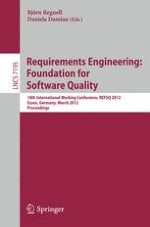2012 | Book
Requirements Engineering: Foundation for Software Quality
18th International Working Conference, REFSQ 2012, Essen, Germany, March 19-22, 2012. Proceedings
Editors: Björn Regnell, Daniela Damian
Publisher: Springer Berlin Heidelberg
Book Series : Lecture Notes in Computer Science
